Is It Safe for Children with Heart Issues to Participate in Athletics?
Let's Talk Sports for Heart-Condition Kids
Hey there! Many youngsters grow up with sports being a big part of their lives. But, what about those with heart conditions? To help clarify this issue, we're chatting with Dr. Akash Patel, a pediatric cardiologist and electrophysiologist at Cleveland Clinic.
Sports participation depends on the child's specific heart condition and how it affects their heart. Some children might have an increased risk of sudden cardiac arrest when playing sports, especially if they have hypertrophic cardiomyopathy. But not all kids with a heart condition will face the same restrictions.
Dr. Patel suggests that kids who have had heart conditions, even those who've undergone surgery, typically don't require additional protective gear for the sports they play. However, certain kids might not be given the green light for every sport. "We generally tell kids who have pacemakers or defibrillators to avoid contact sports," warns Dr. Patel.
Before diving into sports, there are some precautions both parents, children, schools, and doctors should consider.
- Pre-Participation Cardiac Screening: Adding a pre-participation cardiac screening to a standard physical can help identify kids at risk for having a concerning cardiac event while playing sports. This screening is often done in collaboration with a cardiologist and primary care provider.
- Emergency Preparedness: Since there's always a risk, even with the best precautions, it's essential to have emergency resuscitation equipment and individuals trained in CPR around. This is crucial for ensuring a quick response if a cardiac event occurs.
- Automated External Defibrillator (AED): Having an AED on hand can be lifesaving when a child experiences a cardiac event. Schools should consider having these devices available for use during sports activities.
Ultimately, the decision to allow a child with a heart condition to participate in sports is a shared one among the child, parents, doctors, and school officials. The primary goal is to create a safe, enjoyable sports environment for children with heart conditions by implementing the right precautions and ensuring everyone's prepared for emergencies.
So, for kids with heart conditions dreaming of playing sports, there's room for optimism. With proper guidelines and preparation, they can safely reap the benefits of sports participation and enjoy the joy of teamwork, social development, and physical activity.
- To protect heart-condition kids during sports, it's crucial to implement health-and-wellness measures such as Pre-Participation Cardiac Screening, designed to identify children at risk for having a cardiac event.
- Sports participation can offer numerous benefits, including fitness-and-exercise, teamwork, and social development, but the environment must prioritize the child's health and safety.
- Science and sports could collaborate to ensure that children with heart conditions can participate in sports safely by developing new fitness-and-exercise protocols, incorporating AEDs in sports facilities for emergencies, and fostering an improved understanding of heart conditions in sports medicine.








